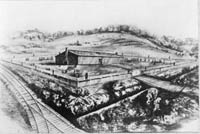Colonial Wars |
American Wars |
Link To This Page — Contact Us —
Cahaba Prisoner of War Camp
Search, View, Print Union & Confederate Civil War Prisoner of War Records, 1861-1865
In January 1864, Confederate authorities decided to establish a permanent prison facility at the unfinished red-brick cotton warehouse at Cahaba, Alabama. They acquired the warehouse for the use as a prison for captured Union prisoners in the summer of 1862. Col. Samuel M. Hill originally owned the warehouse, and had constructed the building as part of a complex to provide storage for the Cahaba, Marion, and Greensborough Railroad. The railroad failed in the 1850’s and the warehouse was abandoned.
The place had been used as a gathering point for the military district's political and Union prisoners for several months, starting in late 1863. The prison was located on the on the central east end of the city on the banks of the Alabama and Cahaba Rivers. The prison was initially built to hold 500 prisoners. It held over 5,000 Union soldiers between 1863 and 1865.
The prison was 15,000 sq. feet, covered by a leaky roof with 1,600 feet of open space in its center and was surrounded by a tall brick wall. The building had 4 open windows and the floor was bare earth. A 12 foot high wide-plank fence was built around the 1/3 acre site. Inside the building, bunks, 5 tier high, were erected along the walls and would hold 432 men. By the end of March 1864, 660 prisoners were held at the prison.
The prison yard, enclosed by a fence, was about 35x46 feet and could be used by the prisoners during the daytime. It also served as the cook yard. Guards patrolled on an elevated walkway around the outside of the fence. Two small cannons protruded out of 2 portholes in the north end of the stockade wall. The walls of the warehouse were about 14 feet high and measured 193x116 feet on the outside.
By May 1864, there were 1,500 prisoners, and the prison was ordered to be closed. The prisoners healthy enough to travel were transferred to Andersonville Prison. When Andersonville became too overcrowded, Cahaba Prison was reopened. By September, there were 2,500 prisoners and that number eventually climbed to 3,000.
There were 2 co-commanders at the prison, with Capt. H.A.M. Henderson sharing command with Lt. Col. Sam Jones. Henderson took charge of the prison facilities, while Jones directed the prison’s guards. The prison guard totaled 179 troops, with a number of them coming from established Alabama reserves
Life & Conditions:
Prisoners were contained in old decrepit buildings which held no provisions for bedding. Instead, prisoners slept on bare floors with one fireplace in the building to keep them warm. There was not any way to heat the building so open fires were allowed on the floor.
The water supply came from an open trench that ran from an artesian well, which had become extremely polluted by the sewer runoff from the town and the prison itself. The well was located 200 yards away, outside the prison wall. According to stories told, the river often flooded and covered the floors of the buildings in waters running 1-4 feet deep.
Rations were the standard issue of raw meat and cornmeal. The prisoners were required to do their own cooking.
The commanding officer at Cahaba Prison was Capt. H. A. M. Henderson. He was a Methodist minister. Due to his overseeing of this prison, prisoners were treated fairly and the death rate was extremely low in comparison to most other prison camps. Due to an increasing rate of sickness, a hospital was established at the Bell Tavern Hotel, 2 blocks away from the prison. The prevailing diseases were scurvy, dysentary, and chronic diarrhea. There were problems with lice, rats, and dysentery. However, Cahaba had access to ample medical supplies, firewood, and food. This contributed to the substantially lower death rate among Cahaba prisoners.
Aftermath:
The Union prisoners from Cahaba prison were to be transferred back to the Federal government. Their trip home ended up in a disaster. It became known as the "Sultana Disaster".
In the early morning hours of April 27, 1865, the steamboat Sultana exploded on the Mississippi River near Memphis, Tennessee. The Sultana was crowded with former Union prisoners-of-war from Cahaba Prison and was carrying over 2,000 people. Of these, 1,500 or more were killed either by the explosion, the subsequent fire, or drowning.

